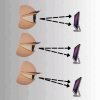Digital Eye Strain: Updated Perspectives
- PMID: 39308959
- PMCID: PMC11416787
- DOI: 10.2147/OPTO.S412382
Digital Eye Strain: Updated Perspectives
Abstract
Purpose: Digital eye strain (DES) is a growing worldwide concern because digital devices are prevalent in both our work and home lives. The purpose of this review was to summarize clinically relevant and evolving key topics related to DES.
Methods: A PubMed.gov search was conducted on or before June 8, 2024. No date restrictions were used during the primary search. The search was aimed at detecting all articles related to DES; thus, the search terms only included "digital eye strain" or "computer vision syndrome".
Results: The two most used, validated DES questionnaires are the Computer Vision Syndrome Questionnaire (CVS-Q) and Computer Vision Symptom Scale (CVSS17). The world-wide prevalence of DES ranges from 8.2% to 100% depending upon the subjects evaluated and the method used to evaluate them. The most common DES symptoms include headache, eye strain, eye redness, eye itching, tearing, photophobia, burning sensation, blurred vision, eye pain, neck and shoulder pain, and eye dryness. Ocular surface symptoms in DES are integrally tied to decreased blink frequency, which causes ocular surface desiccation, increased osmolarity, and dry eye-like symptoms. The most studied DES-specific treatments are improving subjects' environment, artificial tears, blinking exercises, and near work breaks.
Conclusion: DES is a highly prevalent condition that should be regularly screened for in clinic with a validated diagnosis instrument. While there are several treatment options, the community's treatment approach is evolving and primarily focused on treating the visual and dry eye-like symptoms associated with the condition.
Keywords: computer vision syndrome; digital device; digital eye strain; prevalence; symptoms.
© 2024 Pucker et al.
Figures
References
Publication types
LinkOut - more resources
Full Text Sources



